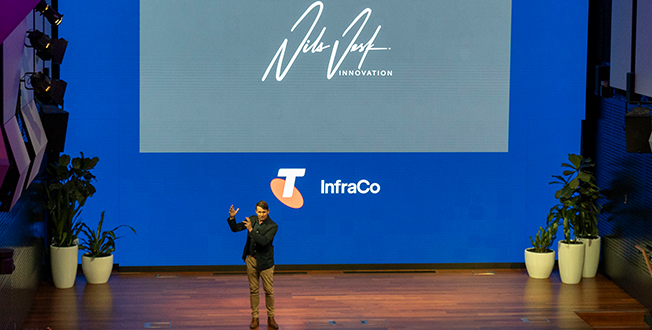A futurist’s perspective on mobile, IoT and messaging trends
The future is arriving faster than ever. For leaders in the mobile, messaging, and Internet of Things (IoT) sectors, looking beyond the day-to-day shouldn’t be thought of as a luxury. It’s essential to have a strategy that helps you take advantage of shifts in technology, culture and consumer expectations.
At a recent event, futurist Nils Vesk provided a compelling glimpse into what consumers will demand by 2030. His core message was a powerful call to action: “To win the future, we must be forewarned to be forearmed, shifting our focus from reacting to trends to proactively leading with them.”
Nils challenged the audience to step into the minds of their consumers by considering their fears, frustrations, desires, and unmet needs. Using this framework, he outlined the transformative trends that are redefining our industry.
1. The hyper-anticipatory consumer mobile experience
“The next generation of mobile services will be defined by intelligent anticipation,” Nils said.
“The leap to 6G, with its blazing-fast speeds and ultra-low latency, is just the beginning. The true revolution lies in what this connectivity will power.”
- From personalisation to prediction: Nils described AI-driven personalisation as a "genie" that anticipates your customers' needs before they do. He used the example of a person who has just been for a run. He described how their AR (Augmented Reality) glasses would then show them an overlay of a recipe for a recovery smoothie, tailored to their unique needs.
- Immersive services: This predictive power will merge with mainstream AR glasses to deliver immersive experiences services. Nils noted several companies he worked with, who had deployed AR glasses to their workforces. He said these workers also increasingly use their AR glasses at home, with virtual gatherings or meetings being a particularly popular use case.
- The rise of super apps: To combat app overload, Nils said the trend of ‘super-apps’ such as WeChat and Alipay will continue to gain traction in Australia. He expects to see the rise of integrated apps that provide a single, seamless interface for everything from payments and food delivery to health and entertainment.
2. The evolution of messaging from chat bubbles to immersive conversations
‘Messaging is set to become dramatically richer, more intuitive, and more deeply integrated into our lives’ Nils said. ‘For messaging providers, this opens up powerful new avenues for creating value.’ He cited the following examples:
- Richer, trusted communication: The broad adoption of Rich Communication Services (RCS) that’s already underway will continue to upgrade messaging experiences. RCS enables messaging providers and their customers to communicate Verified branding, high-quality media, and clickable previews, offering incredible marketing opportunities.
- Context-aware intelligence: Future messaging systems will understand the user's real-life context. Nils cites the example of getting a phone call during a typically busy weekday morning. Instead of a generic "I'm busy" auto-reply, a phone will know its user is on the school run and send a more authentic and appropriate message on their behalf.
- Seamless multimodal communication: Communication will evolve beyond just typing and talking. Nils describes a future where we can blend high-quality video and send holographic emojis or images to create more seamless, inspiring, and engaging messages.
- AR-enhanced messaging: AR has the potential to make communication even more engaging. ‘Imagine a friend's digital avatar appearing in your lounge room to deliver a message or have a chat, with video projected into, and adapting to, the environment.’
3. The emergence of the autonomous IoT
‘The Internet of Things is evolving from a network of connected devices into a truly intelligent and autonomous ecosystem,’ Nils said. The next phase of transformation will see IoT service providers shift their focus from monitoring to enabling self-sufficiency.
- Pervasive, intelligent connectivity: In the near future Nils said, a "hyperactive data chain" will connect everything from our smartwatches to our refrigerators. He shared a vivid example of a connected home working towards a person’s health goals, where a smartwatch communicates with the fridge to prevent late-night ice cream binges.
- Autonomous systems: The potential of AI-enableed, hyper-connected devices goes beyond devices that monitor status updates, towards systems that make decisions. ‘We are heading towards a future of self-managing devices,’ Nils said. ‘A future of self-repairing machines, or refrigerators that re-order milk before you even know you’re running low.’
- Built-in security: With billions of sensors operating in the world, Nils stressed that security and privacy will be paramount. ‘The future of IoT includes built-in "data bodyguards", advanced, real-time threat detection and encryption to keep consumer data safe.’
An innovator’s toolkit
While these trends may seem daunting, Nils emphasised that innovation doesn't have to be a slow or painful process. He argued the biggest barrier to innovation is often a perceived lack of time. His research shows that teams can generate 80% of their most effective ideas in under five minutes with two things in place: a clear prompt and one simple rule.
The prompt can be a simple question. Nils shared his "SCRAMBLE" acronym—a Swiss Army knife of questions to spark new thinking: What can we Substitute, Combine, Reverse, Adapt, Modify, Break up, Leverage, or Eliminate?
And the single, simple rule? Separate idea generation from evaluation. Don't judge ideas as they arise, as this kills the creative process.
The challenge for leaders: lead, don’t react
With the transformations delivering the 2030 future already well underway, now is the time to consider how to reshape your supply chains, customer service, and the very products you offer.
As Nils put it, the critical question for every leader is not, "which of these trends should we react to?" but rather, "what plans should we make so we can lead these trends?"
“By understanding what your customers will want and by arming your organisations with a proactive innovation mindset, you can move forward with confidence,” Nils concluded. “You’ll be ready to capture new market share and deliver the exceptional results your customers and your businesses deserve.”





